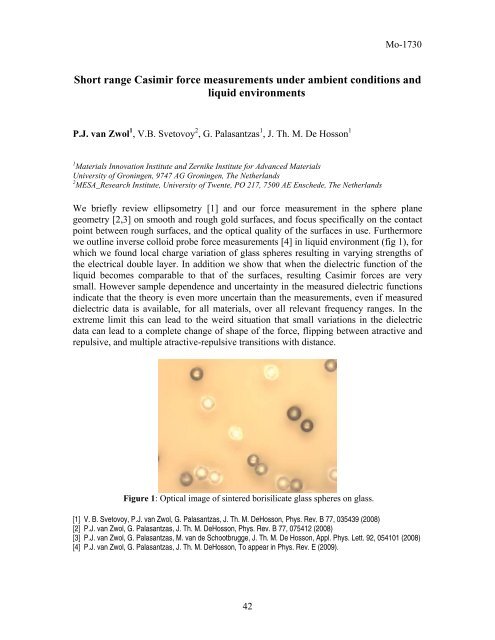Noncontact Atomic Force Microscopy - Yale School of Engineering ...
Noncontact Atomic Force Microscopy - Yale School of Engineering ...
Noncontact Atomic Force Microscopy - Yale School of Engineering ...
You also want an ePaper? Increase the reach of your titles
YUMPU automatically turns print PDFs into web optimized ePapers that Google loves.
Mo-1730<br />
Short range Casimir force measurements under ambient conditions and<br />
liquid environments<br />
P.J. van Zwol 1 , V.B. Svetovoy 2 , G. Palasantzas 1 , J. Th. M. De Hosson 1<br />
1 Materials Innovation Institute and Zernike Institute for Advanced Materials<br />
University <strong>of</strong> Groningen, 9747 AG Groningen, The Netherlands<br />
2 MESA_Research Institute, University <strong>of</strong> Twente, PO 217, 7500 AE Enschede, The Netherlands<br />
We briefly review ellipsometry [1] and our force measurement in the sphere plane<br />
geometry [2,3] on smooth and rough gold surfaces, and focus specifically on the contact<br />
point between rough surfaces, and the optical quality <strong>of</strong> the surfaces in use. Furthermore<br />
we outline inverse colloid probe force measurements [4] in liquid environment (fig 1), for<br />
which we found local charge variation <strong>of</strong> glass spheres resulting in varying strengths <strong>of</strong><br />
the electrical double layer. In addition we show that when the dielectric function <strong>of</strong> the<br />
liquid becomes comparable to that <strong>of</strong> the surfaces, resulting Casimir forces are very<br />
small. However sample dependence and uncertainty in the measured dielectric functions<br />
indicate that the theory is even more uncertain than the measurements, even if measured<br />
dielectric data is available, for all materials, over all relevant frequency ranges. In the<br />
extreme limit this can lead to the weird situation that small variations in the dielectric<br />
data can lead to a complete change <strong>of</strong> shape <strong>of</strong> the force, flipping between atractive and<br />
repulsive, and multiple atractive-repulsive transitions with distance.<br />
Figure 1: Optical image <strong>of</strong> sintered borisilicate glass spheres on glass.<br />
[1] V. B. Svetovoy, P.J. van Zwol, G. Palasantzas, J. Th. M. DeHosson, Phys. Rev. B 77, 035439 (2008)<br />
[2] P.J. van Zwol, G. Palasantzas, J. Th. M. DeHosson, Phys. Rev. B 77, 075412 (2008)<br />
[3] P.J. van Zwol, G. Palasantzas, M. van de Schootbrugge, J. Th. M. De Hosson, Appl. Phys. Lett. 92, 054101 (2008)<br />
[4] P.J. van Zwol, G. Palasantzas, J. Th. M. DeHosson, To appear in Phys. Rev. E (2009).<br />
42















